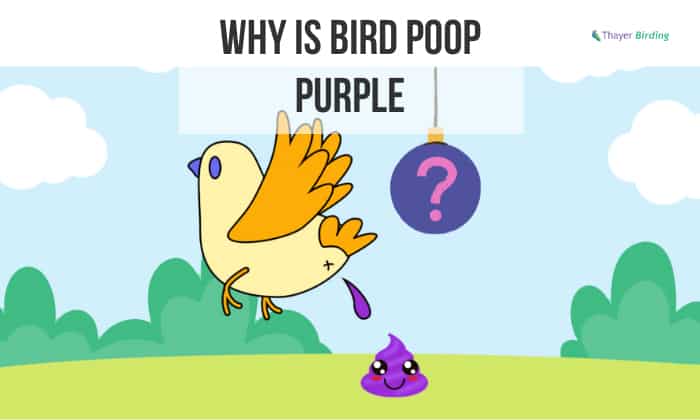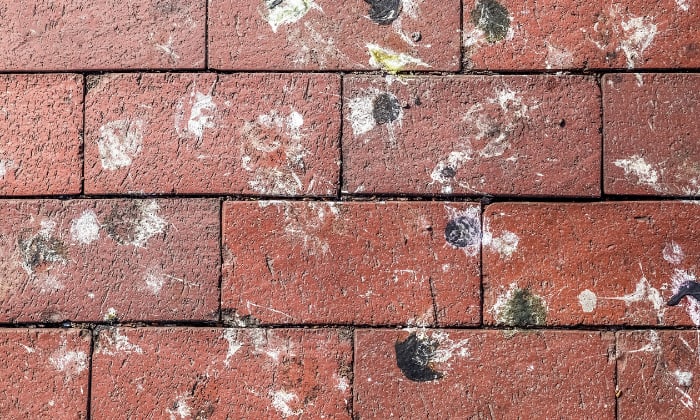Have you ever looked at a patch of bird poop that was a strange shade of purple and thought, “Why is bird poop purple?”
When birds eat different fruits, they eat the colors that are in those fruits. The pigments can make their droppings look purple or take on other bright colors.
Today, we’ll learn more about bird poop and how to tell the difference between normal and abnormal bird droppings, which will help you understand more about how our winged friends’ bodies work.
Table of Contents
What Causes the Purple Color in Bird Poop?
Ever seen a vibrant or dark purple surprise in your feathered friend’s poop? This unexpected burst of color often leaves us pondering about our bird’s well-being and food choices.
So, let’s learn more about purple bird poop and discover the reasons behind it:
1. Purple Fruits and Insects
Birds such as pigeons and starlings are known connoisseurs of nature’s colorful bounty. They can’t resist cherries, blueberries, or blackberries, which are all rich in a pigment called anthocyanin.
These compounds, found in brightly hued fruits and veggies, are known to transform the shades of avian droppings. As these anthocyanin-laden fruits enter a bird’s digestive system, they can give rise to the strange purple bird poop.
The same thing happens when avians eat purple insects.
2. Food-coloring Pigments
Store-bought treats and commercial bird feed can sometimes contain artificial food dyes. When ingested, these pigments result in the appearance of purple bird excrement.
3. Bird Medicines and Vitamins
Certain medicines, antifungals, or vitamin supplements might contain pigments that result in purple bird shit.
4. Ingesting Foreign Objects
Birds, with their curious beaks and playful nature, sometimes find themselves in possession of non-food items, like small purple toys.
Munching on these can temporarily turn their poop into a shade of purple. Remember, foreign objects can be perilous. If your pet bird ingests non-food items, it’s wise to seek immediate veterinary assistance.
5. An Underlying Health Issue
Purple poop can also signal underlying health concerns among birds. Changes in pigment to purple may be linked to conditions such as liver disease, gastrointestinal bleeding, or poor nutrient absorption.
Normal versus Abnormal Bird Poop
Understanding the reasons behind the appearance of bird poop is no easy feat. Yet, these seemingly harmless deposits of waste hold valuable insights into birds’ well-being.
In the following sections, we’ll learn more about the differences between normal bird poop and abnormal bird poop.
What’s Normal or Healthy Bird Poop?
The color is the easiest way to determine whether your feathered friend’s poop is normal or healthy.
1. White
The white component of bird droppings, known as urate, is a byproduct of their kidney function. In texture, it often resembles chalk or paste, and its coloration tends to be on the whiter side of the spectrum.
2. Brown or Green
The green or brown bird poop are the remnants of consumed food and the waste products produced during digestion. They come together to form the fecal component, imparting color and texture to the droppings.
3. Variations in Hue
Birds are known to exhibit variations in the coloration of their droppings. For instance, raptors may display a spectrum of hues ranging from yellow to green due to the presence of bile pigments.
Bald eagles and ospreys, meanwhile, often have white poop but never purple. Dropping colors can change depending on bird species and their preferred food sources.
What’s a Not So Normal Bird Poop?
Even though it’s not the most exciting part of caring for birds, knowing the signs of strange bird poop can help you keep an eye on your bird’s health. Here are some important things to look for in your bird’s daily poop:
- Quantity Matters – Changes in the number of droppings or regularity of droppings that aren’t normal can be a red flag.
- Color and Appearance – The color and look of your bird’s poop and urine can tell you a lot about how healthy it is. Keep an eye out for anything that isn’t normal, as it can be a sign of bigger problems.
- Bubbly Droppings – Droppings that are “bubbly” are another sign to look out for. These can be a symptom of digestive troubles or infections.
- Polyuria – Excessive Urination – Polyuria is the medical term for having to go to the bathroom too often. If you notice that your bird is peeing more than normal or have abnormally watery poop, you should find out why.
- Blood and Unusual Smells – Do not ignore blood spots or unusual smells. Different health problems, like infections or problems with the cloaca can cause these symptoms.
Reasons for Abnormal Droppings
It’s important to know that bird diet can affect the color and consistency of its droppings. Also, birds that eat a lot of juicy or watery foods (such as watermelons) may urinate more than usual.
Diet can cause brief changes in poop, but changes that don’t go away could be a sign of a bigger health problem like intestinal problems, liver problems, infections, or parasites.
Thus, when checking bird droppings for health problems, you have to be very careful as well as observant. Look at the color, how it changes, and how often it happens to spot the differences.
If you aren’t sure about your bird’s health, talk to a veterinarian who specializes in avian care to ensure your bird receives the best possible treatment.
Conclusion
The answer to “Why is bird poop purple?” is a fascinating look into how nature works. Everything has to do with the berries and fruits that birds eat, especially those that are high in anthocyanins.
And though purple bird droppings may be harmless, they can also indicate serious health problems your feathered companion has. So, the next time you see a splash of purple in your bird’s poop, remember the information we discussed here.
And if you’re wondering how to remove avian poop stain from your yard, hot water and washing soda should work well.

George and I became friends after a birdwatching trip with our new group. And we have been enjoying every adventure together. When he told me the idea of establishing a site that shares our experiences and fun, I immediately agreed. After trials and errors, here we have Thayerbirding.


















